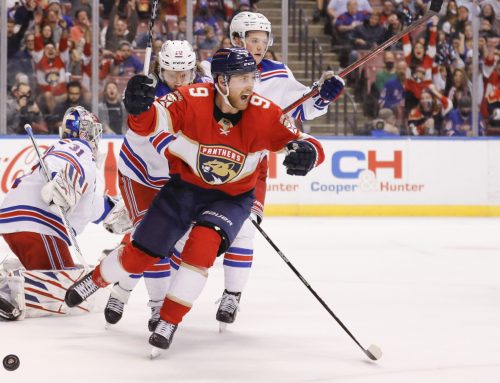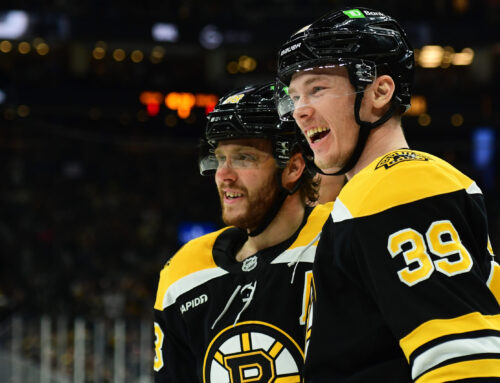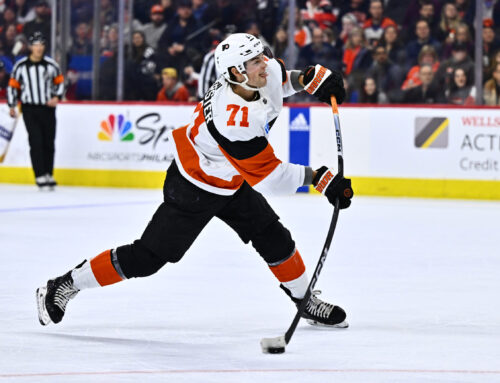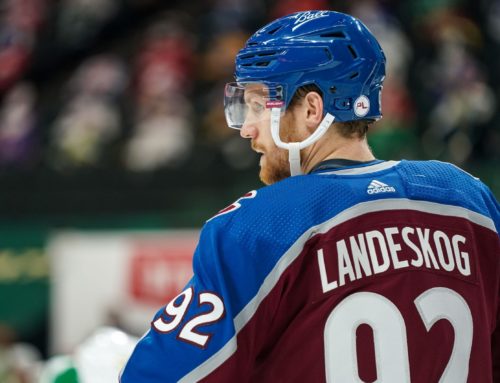
Game 6 between Washington and Tampa Bay was everything a playoff game, and specifically an elimination game, fans want it to be. It was end-to-end action despite the lack of goals, lots of physicality, great goaltending, and fingernails bitten down to nubs. It was undoubtedly one of the best games of the playoffs.
Both Andrei Vasilevskiy and Braden Holtby were excellent in this game, with the latter managing a 3-0 shutout to get us to a Game 7. If that game is anything like this game, Caps and Bolts fans may not have a non-gray hair left on their collective heads.
TJ Oshie scored a power-play goal late in the second period that would stand as the game-winner. Devante Smith-Pelly added a tally midway though the third period for the added insurance with Oshie scoring an empty-netter.
The top lines came to play for Washington as Ovechkin, Vrana, Oshie, and Kuznetsov all had at least four shots on goal. It was also a great game from Nick Backstrom in all facets.
Whatever the outcome, this has been a great series. Strap in for Wednesday night, everyone.
*
There was an interesting document posted by Matt Cane yesterday on Twitter. Cane is an editor at Hockey Graphs and does a lot of work on NHL contracts, namely in predicting length and value. Every year, he posts his model’s prediction of free agent contracts. You can go through his google doc here and he composed a tweet thread to explain some updates to this model.
This is a good starting point for those in cap leagues that are going to begin their preparations for next year shortly. I also recommend reading Alex MacLean’s ‘Capped’ sections. There was a good read last week on guys who were injured last year and what to do with their contracts.
These are always good discussion points. Here are a few guys that stuck out to me.
Coming off seasons of 29 goals and 36 goals, I’m sure most people are expecting him to get something like TJ Oshie got last year. Or maybe a shorter term for a higher AAV. Cap league keeper owners of JvR would likely be thrilled if he was given a short term at a reasonable AAV of about $5.3M.
The hockey world is waiting with impatience to see what a player with no track record of high-level production putting up a 43-goal, 78-point performance being due an RFA contract will get. A month ago, I intimated that his contract could be similar to what Jonathan Marchessault received, if only a bit higher AAV. Mr. Cane’s model seems to agree. Repeating 40+ goals will be near impossible, but that contract would be fine if he settles into the 20-25 goal, 55-60 point range.
SOMEONE SEND ZUCKER AN OFFER SHEET.
The Jets have some work to do this summer. Both Trouba and Connor Hellebuyck need new contracts, they have a lot of guys in their bottom-six that need new deals or need to be replaced, and they’re a year away from having to sign Patrik Laine and Kyle Connor to, presumably, long-term deals. Not to mention this is the last year of Blake Wheeler’s contract and he’ll be 32 years old. They have most of their core locked up already and I don’t think they want to go through more negotiations with Trouba like they have in the past. A one-year deal would be great for Winnipeg, but seeing as Trouba has one season with 30 points in five years, now might be the time to lock him up long-term. If he breaks out for 44 points or something this year, he’ll be a lot more expensive 12 months from now.
I like John Carlson a lot as a defenceman and think he comes in somewhere close to the number listed in the google doc, but man that feels like a mistake waiting to happen. The team that signs him to that deal will need him to be their sure-fire top blue liner in all phases, and can he do that for eight more years? He’s still only 28 so maybe he can do it until he’s 35. What do you Dobber heads think?
*
A couple weeks ago, I wrote about how Vegas wasn’t a team of misfits. There were a lot of good players that ended up on that roster. No, I didn’t think they’d even make the playoffs even with that roster, but to pretend they were given bags of garbage is misguided. Two things can be true simultaneously: that there are good players on a roster and that roster wasn’t seen as good enough for playoff qualification. I know, crazy, right?
Something else to take issue with: that the rules were setup to give Vegas a good team. Again, they were going to get good players: they were going to get one of Marc-Andre Fleury or Matt Murray from Pittsburgh, they were going to get one of James Neal or Calle Jarnkrok from Nashville, they were going to get a good defenceman from Anaheim, etc. But remember this:
Vegas' playoff run and means of player acquisition:
#1 scorer: trade
#2 scorer: trade
#3 scorer: trade
#4 scorer: draft
#5 scorer: trade
#6 scorer: trade
#1 scoring defenseman: trade
#1 goaltender and probable MVP: trade📢 advertisement:— Travis Yost (@travisyost) May 20, 2018
Other teams tried to take advantage of Vegas with their cap space and ability to take bad contracts. The Islanders wanted to get rid of Mikhail Grabovski, the Blue Jackets wanted to get rid of David Clarkson, the Panthers (for some unknown reason) wanted to get rid of Reilly Smith. The NHL forced teams to give up a middle-of-the-roster player, but they didn’t force teams to make all these trades. If fans should get angry at anyone, they should get mad at the awful general managers and penny-pinching owners.
Will some franchises learn from this the next time expansion comes around (they better be named the Seattle Krakens)? Some will. Some won’t. Kudos to George McPhee, though. He used cap space as the asset he should have and the roster is now setup to be a playoff contender for years.
Also, this is not an embarrassment for the league. The GMs? Sure. Not the league. I’m not a television production expert but having Vegas in the Cup Final instead of Winnipeg should bring many more eyeballs to the television. This is one of the biggest stories in the sports world at the moment. Can an expansion team pull off the seemingly impossible? That’s something that will draw viewers.
Just enjoy the ride.
*
It was announced that Marian Hossa will indeed retire from the NHL that he will let his contract run through. If someone more familiar with the CBA wants to chime in please do so in the comments but I think that lets them put him on the LTIR and not endure cap penalties.
You can read Dobber’s take on his retirement in that link.
I remember like 10-11 years ago when I was talking NHL with a friend of mine and Hossa’s name came up. I wasn’t a big fan of his back then, so my friend asked me, “name 10 wingers better than him right now.” I think I came up with about five or six at the time. It was then that I realized just how good he was.
Hossa’s first full season was 1998-99. His last full season was 2016-17. In that span, he posted the third-most goals (525, behind Jarome Iginla and Alex Ovechkin), the ninth-most assists (608, just 19 behind Iginla despite 100 fewer games played), and the fourth-most points (1133, behind Joe Thornton, Iginla, and Jaromir Jagr). Though he didn’t really garner the reputation until the latter half of his career (to my recollection, anyway), he was regarded as an elite defensive winger as well. Not only do we have a career where Hossa was one of the absolute elite offensive players, he was considered among the elite defensive players as well.
People may point to the lack of Selke Trophies as if it were some determination of his defensive value, but the fact is wingers just don’t win the award. The last winger to be named the NHL’s top two-way forward was Jere Lehtinen in 2002-03, and he’s the only one to win it this century. A winger has won the Selke nine times and seven of them were by Lehtinen and Bob Gainey back when the trophy was first introduced. It just doesn’t happen.
Regardless of where you stand on Hossa as a defensive winger (I think he’s one of the best of this generation), the offensive stats don’t lie. He’s truly one of the top talents on the wing we’ve seen enter the NHL, from an offensive perspective, in the last couple decades. If you’re among the people who think he was an elite defensive winger as well, you then start to wonder if not only does he belong in the Hall of Fame (he absolutely does) but where he stands in the pantheon of elite wingers in the history of the game.
*
Last week was spent discussing the changing trends in five-on-five shooting. The most important takeaways were that not only are shot attempt rates increase significantly league-wide, but shooting percentages also rose despite a larger percentage of the actual shot on goal increase coming from defencemen than forwards.
This week, the power play.
Last month, the topics of goal scoring from defencemen on the power play as well as power-play time allocation were already covered. Those are good primers to peruse before going further here.
With power-play allocation to defencemen decreasing, we would expect a big decline in total shots on goal by defencemen to decline. This is what it looks like (data from Natural Stat Trick and all power play strengths included):

Notice the uptick this season. Despite a lower percentage of power-play minutes given to defencemen from all available PP minutes (as outlined in the link a couple paragraphs above), and a decline in total minutes from 2016-17 (a little over 17 564) to 2017-18 (a shade under 17 000), we had more shots on goal. Here’s the thing: we had fewer shot attempts in 2017-18 (6543) than in 2017-18 (6731), but more shots on goal. The shots on goal difference isn’t overly significant, but it’s just curious what happened. Is it related to strategy i.e. were penalty killers more willing to let 50-foot slap shots through and instead tried to take away half-wall one-timers or climbers? Were defencemen focusing less on a getting a booming shot off and instead trying to thread the needle? Given the difference is so small, is it just random?
I don’t think it’s a coincidence that as defencemen have been taking fewer shots, league-wide power-play conversions have been rising. In 2013-14, teams converted on 17.89 percent of man advantages, according to Hockey Reference. In 2015-16, that was 18.66 percent, rising over 20 percent last year. The old adage of “get traffic, hammer the puck, drive in rebounds” maybe isn’t the ideal way to go. There is obviously more than one way to score a goal but teams seem to be focusing more on half-wall one-timers, wingers climbing down the half-wall with options, cross-seam passes, or redirections at the side of the net.
There will be a bit more written on this subject later this week.
*
Speaking of power plays, a good read from Ryan Stimson on how a power play ran from behind the net would work. These are always fascinating articles because thinking outside the box (literally, in this case) is a way to get ahead of the curve. As I mentioned earlier, power plays are incredibly efficient right now but as Mr. Stimson points out in his article, with everyone adopting a 1-3-1 setup, teams know what’s coming. Maybe some teams will look to change things up in the next couple seasons?





 DET
DET DAL
DAL FLA
FLA NYR
NYR MTL
MTL CHI
CHI NSH
NSH UTA
UTA EDM
EDM L.A
L.A VAN
VAN S.J
S.J TOR
TOR PHI
PHI CAR
CAR CBJ
CBJ NYI
NYI N.J
N.J BUF
BUF WSH
WSH
